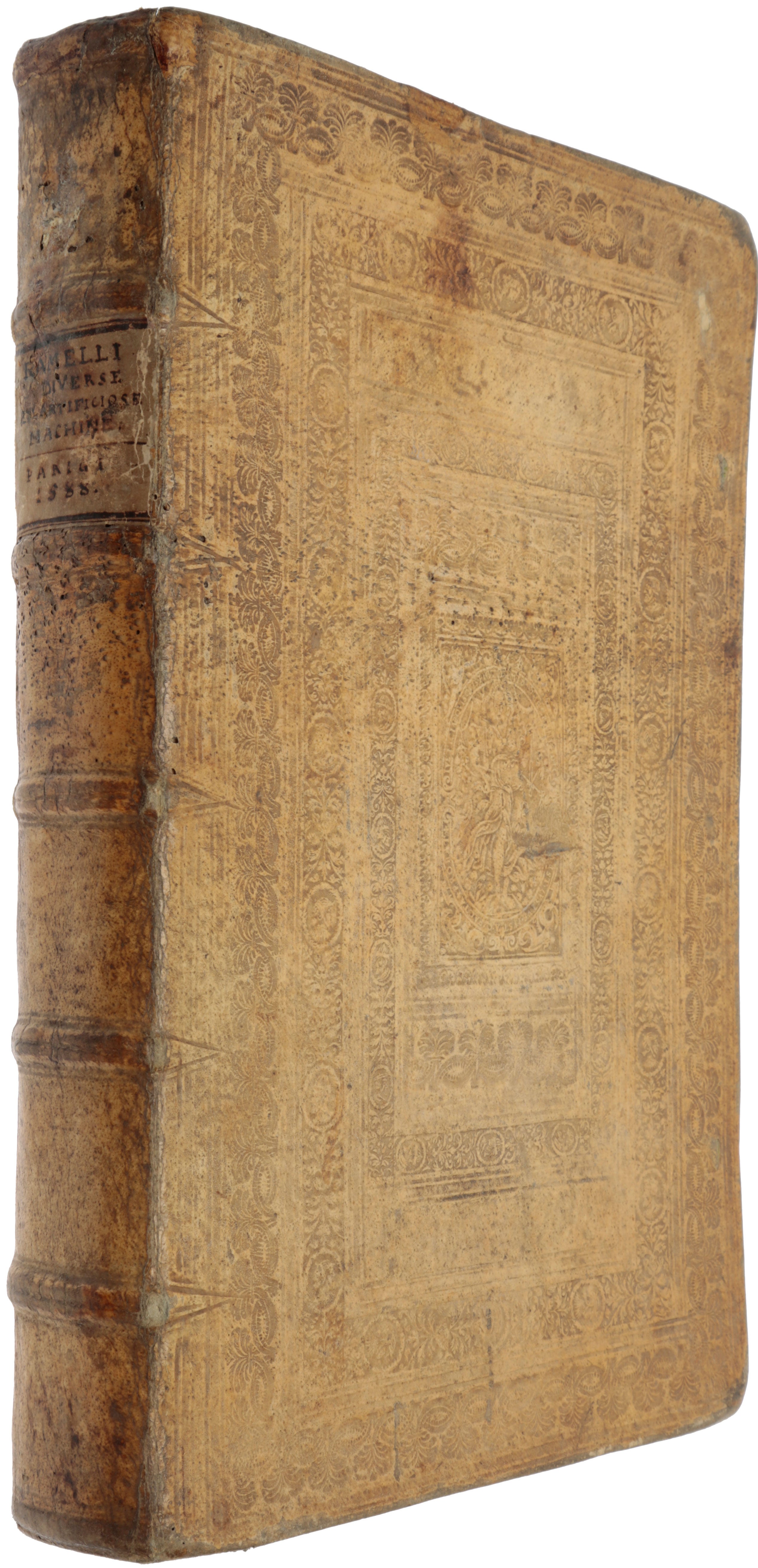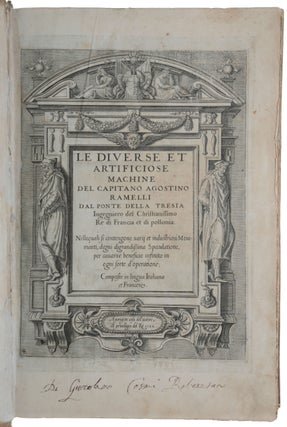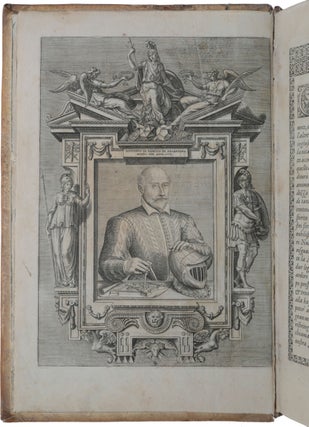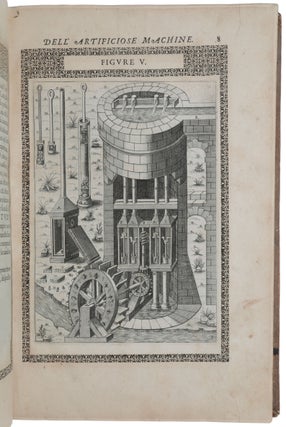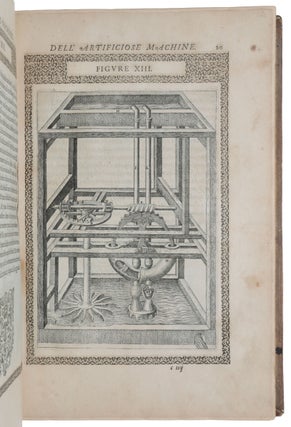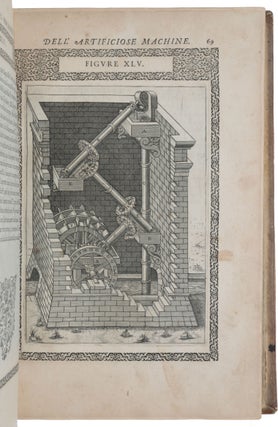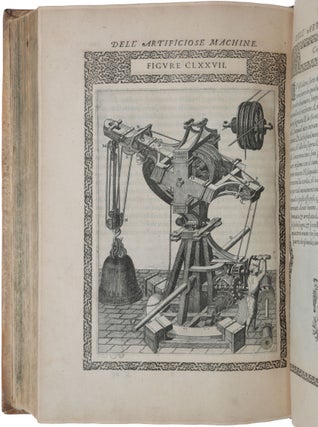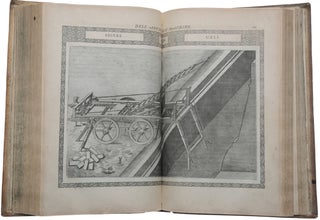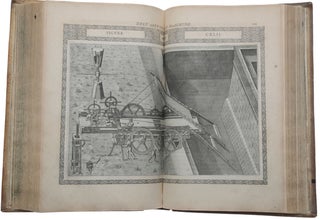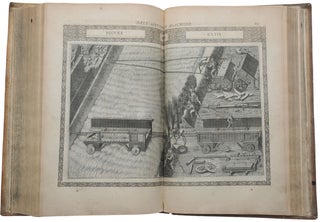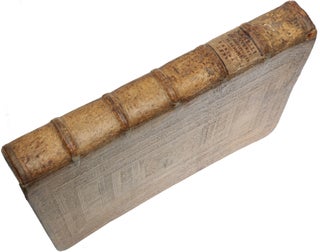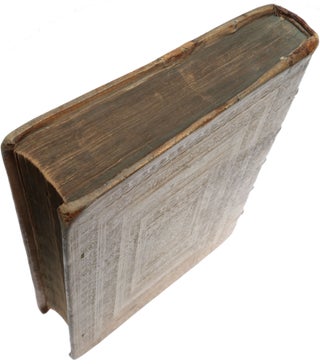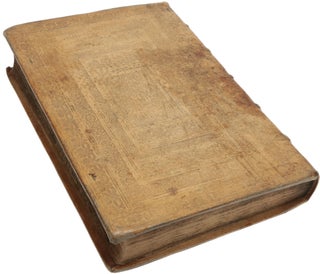Le Diverse et Artifiose Machine... Nelle quali si contengono varii et industriosi Movimenti, degni di Grandissima Speculatione, per cavarne beneficio infinito in ogni sorte d'operatione.
Paris: for the author, 1588. First edition, in a beautiful contemporary binding, of one of the most famous illustrated books of the sixteenth century and a landmark in book design. “The military engineer Agostino Ramelli produced a remarkable illustrated book in 1588 describing a large number of machines that he devised. Called Le diverse et artificiose machine del Capitano Agostino Ramelli (The various and ingenious machines of Captain Agostino Ramelli); this work had a great impact in the field of mechanical engineering. The book contains 195 superb engravings of various machines along with detailed descriptions of each one in both French and Italian” (Brashear). About half of the engravings depict hydraulic devices, the rest showing military machines as well as fountains, bridges, cranes, foundry equipment, etc., and a smattering of innovative devices such as the famous ‘reading wheel’ or the bouquet with artificial singing birds. In addition to weapons, 13 chapters are devoted to machines for breaking and entering – forcing doors, lifting doors off their hinges, cutting through metal fences – and all of which Ramelli insists can be accomplished without the perpetrator being discovered! “The plates in Ramelli’s treatise are artistically as well as technologically superb, the bilingual text beautifully printed, and both plates and text surrounded by handsome borders of typographic ornaments. The reasons for this sumptuousness were twofold: first Ramelli had dedicated the book to his patron Henri III; and second, he had previously had several designs stolen from him by a trusted associate (probably Ambroise Bachot, later engineer to Henri IV), who published them in corrupt and mutilated form and claimed them as his own. As a result of this experience Ramelli planned his treatise as a particularly lavish work that would be difficult to counterfeit, and produced and published it from his own house where he could maintain absolute control over the project” (Norman). Together with Agricola’s De Re Metallica (1556), Ramelli’s work was the most influential and copied of all the early illustrated manuals of inventions and machines. Its influence was felt in such later works as Böckler’s Theatrum machinarum (1662), and it was even copied in China, where it had been taken by Jesuit missionaries. Provenance: Girolamo Cosmi Rovereto (Ownership signature on the title); Roger Paultre (small label on fly leaf – see his Catalogue, Grands siècles et grandes images, 1993, no. 247). “Ramelli was born in northern Italy, probably in 1531. As a young man he served under the famous Italian warlord, Gian Giacomo de' Medici, Marquis of Marignano, and became trained in mathematics and military engineering. His reputation grew and he eventually left for France to serve under the Duke of Anjou, later King Henry III. His year of death is unknown and usually given as ‘circa 1600,’ but since documents exist to show that he was still alive in 1608, circa 1610 is a more realistic approximation. “Ramelli was greatly influenced by the increasing importance placed on mathematics and geometry as an important tool for engineers and artists, and particularly by the writings of Guidobaldo del Monte (1545-1607) and Petrus Ramus (1515-1572). Ramelli's interest in mathematics is demonstrated in the preface to his book, ‘On the excellence of mathematics in which is shown how necessary mathematics are for learning all the liberal arts.’ Ramelli also wanted to make his book accessible to many engineers so, as an Italian living in France, he produced both Italian and French descriptions of the machines. “The book itself is a fine example of the exquisite work of late sixteenth-century French printers and artists. It is a large book in folio format thus allowing great detail to be placed in the numerous engraved plates which total 195 in all (although plates 148 and 149 are combined into one image). Twenty of the plates are two-page spreads. Ramelli's bilingual descriptions are much more detailed than those found in previous illustrated books of machines (popularly called ‘theaters of machines’) by Jacques Besson (Theatrum instrumentorum et machinarum, 1569) and Jean Errard de Bar-le-Duc (Le premier livre des instruments mathématiques mechaniques, 1584). “Ramelli's book had a great influence on future mechanical engineering as can be see in Georg Andreas Böckler's work, Theatrum machinarum novum, 1662, where he copied eighteen of Ramelli's plates. Ramelli's influence can also be seen in the well-known works of Grollier de Servière (Recueil d'ouvrages curieux de mathematique et de mecanique, 1719) and Jacob Leupold (the multi-volume set Theatrum machinarum, 1724-1739). Leupold's work helped pass along Ramelli's ideas to a large population of eighteenth-century engineers. “Of the 195 machines pictured in the book, the majority are of devices designed to raise water. The breakdown is as follows: “Bachot was an apprentice and assistant to Ramelli, eventually becoming an architect and engineer to King Henry IV. As described in Gnudi’s introduction to her translation of Ramelli, during the sixteen years he spent with Ramelli, Bachot learned a great deal about engineering but had a falling out with the elder engineer and attempted to pass off some of Ramelli's machine designs as his own in an attempt to gain patronage. These designs were published in 1587 in a book by Bachot, Le Timon, and the similarity in style between Bachot's engravings and Ramelli's is impressive. After intense research, Gnudi concluded that Bachot engraved the plates for his own work and most of those produced for Ramelli's book as well. After their falling out in 1587, Ramelli still used the plates Bachot engraved for him rather than have them redone. Gnudi never claimed that Bachot produced the original drawings, but rather engraved the plates after Ramelli’s drawings. “Only the one edition of the book was issued during Ramelli’s lifetime. In 1620, a German translation appeared in Leipzig as Schatzkammer, mechanischer Künste..., published by Henning Grossen den Jüngern with the illustrations re-engraved by Andreas Bretschneider. A number of facsimile reprints have appeared since 1970 and in 1976 an English translation was prepared by Martha Teach Gnudi and Eugene S. Ferguson and published jointly by the Johns Hopkins University Press and the Scholar Press” (Brashear). Adams R-52; Cockle 788; Dibner 173; Mortimer (French) II.452; Norman 1777; Riccardi I.341; Wellcome 5323. Brashear, ‘Ramelli’s Machines: Original drawings of sixteenth century machines’ (sil.si.edu/ondisplay/ramelli/intro.htm). Brun, Le livre français illustré de la renaissance (ed. 1969), p. 280; M.T. Gnudi, ‘Agostino Ramelli and Amrboise Bachot,’ Technology and Culture 15 (1974), pp. 614-25; modern edition and translation, ed. Gnudi & Ferguson (1976).
Folio (333 x 220 mm), ff. [16], 338. Roman (French) and italic (Italian) types. Engraved title within architectural frame by Leonard Gaultier, each leaf of text printed within a border of typographical fleurons, engraved portrait of Ramelli by Gaultier on title-page verso, 194 engravings (174 full-page, 20 full-sheet) numbered I-CXCV (CXLVIII and CXLIX combined on a single engraving), three signed with the cipher 'JG' (CL-CLII), which some bibliographers have identified as Jean de Gourmont; the remaining plates are unsigned but have been assigned to Bachot by Gnudi. Contemporary blind-stamped pigskin, manuscript paper label on spine (minor repair to front cover, stain on rear cover, spine with tiny wormholes).
Item #5502
Price: $65,000.00

